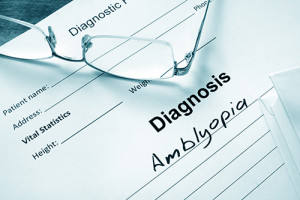Amblyopia (Lazy Eye)
 Amblyopia is commonly referred to as lazy eye. It is a visual condition that is manifested by reduced vision in a healthy eye, which is not correctable by wearing glasses or contact lenses.
Amblyopia is commonly referred to as lazy eye. It is a visual condition that is manifested by reduced vision in a healthy eye, which is not correctable by wearing glasses or contact lenses.
It is estimated that about 1 in 30 individuals have Amblyopia (3%). Amblyopia is a preventable condition when detected in infancy. However, the majority of patients are identified after Amblyopia is established. Over time, the patient develops some bad vision habits and, in effect, the brain turns off their Amblyopic eye. This suppression of one eye leads to stereo blindness and deficient depth perception, along with other associated symptoms.
Age is not a barrier! It is never too late to treat a lazy eye!
While historically it was felt that nothing could be done about amblyopia after the age of seven, new research and clinical experience have shown that amblyopia can be treated successfully at any age.
The tradition of patching the “good eye” has fallen from favor as research demonstrates that constant patching can damage the binocular cells of the eye. Further, as most parents and doctors know, patient compliance is poor because of the many negative side effects of patching and Atropine. Kids just don’t want to wear their eye patch and atropine drops can cause light sensitivity and disorientation. As a result, Amblyopia doesn’t always improve with occlusion therapy alone.
At Indiana Vision Development Center, PC, we provide newer treatment methods which utilize minimal patching combined with appropriate activities that stimulate both the monocular and binocular cells of the eye. There are no negative side effects and our patients experience significantly better results than with occlusion therapy, including improved depth perception.
Our Advanced Binocular Vision Treatment includes:
- Binocular vision therapy with 3D gaming
- Perceptual learning
- Visual Processing development
- Oculomotor Therapy
- Accommodation “focusing” development
- Eye-hand coordination training

